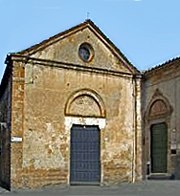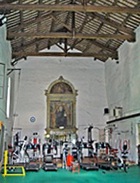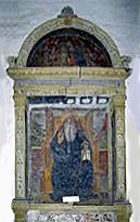


This church and monastery belonged to the Canons Regular of St Antony of Vienne (the name given to St Antony Abbot after his relics were taken to Vienne in 960). This order was dedicated to the care of the sick, and the complex at Orvieto included an adjacent hospice.

The complex was suppressed in 1860 and reported to be in ruins in a guide published in 1896. Until the end of the Second World War, people brought their animals to the piazza outside the church on the feast of St Antony Abbot for a blessing. The church has since been converted for use as a gymnasium.
St Antony Abbot enthroned (ca. 1493)

In the central scene of the altarpiece, St Antony raises his right hand in blessing. The scene in the lunette depicts the Madonna and Child with angels. There were also narrative scenes below the central panel, but these are now illegible.
Read more:
The church is described and the altarpiece is discussed and illustrated in:
L. Guidi di Bagno, “La Pittura del Tardo Quattrocento e Inizi del Cinquecento nelle Chiese e nei Palazzi di Orvieto”, in
C. Benocci et al. (Eds), “Storia di Orvieto: Quattrocento e Cinquecento” (2010) Pisa, Volume II (pp 417-9)
Return to Monuments of Orvieto.
Return to Walk III.

